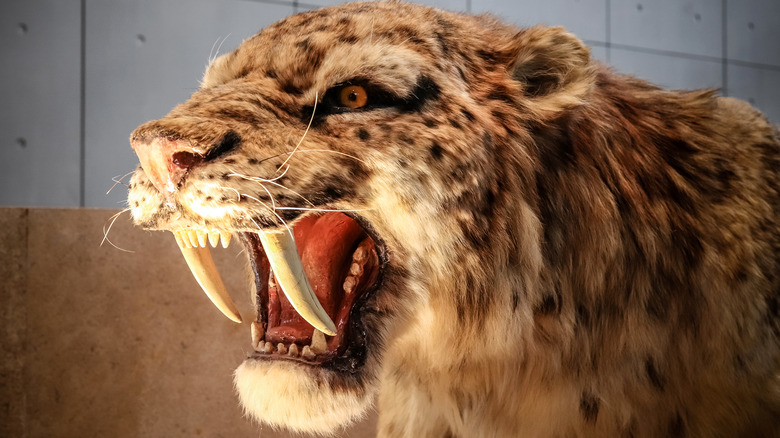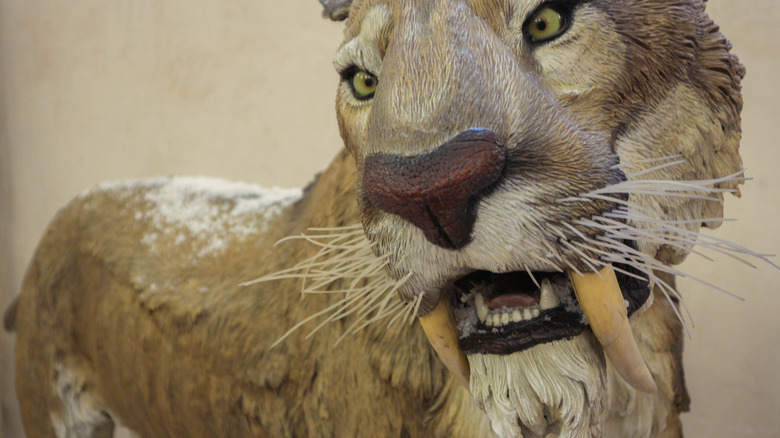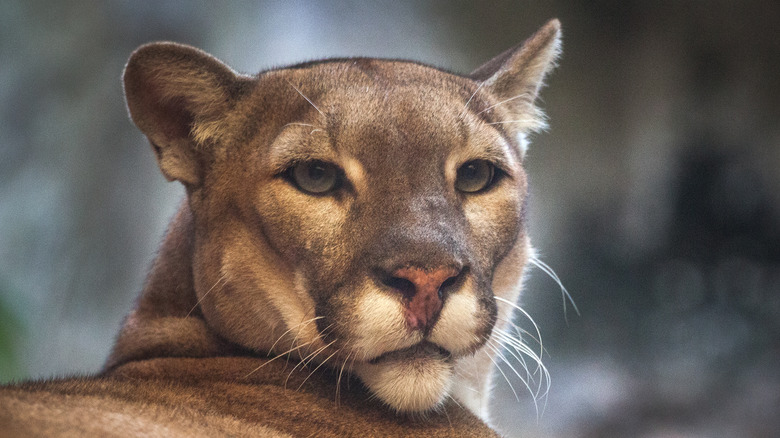What Might Happen If Saber-Toothed Tigers Lived Today?
The megafauna, or giant animals, that have lived during the Ice Age offer a consistent source of fascination for young and old alike (via Live Science). Among the most well-known megafauna during the time period is the genus of feline called Smilodon, also known as the saber-toothed tiger or saber-toothed cat, as the University of California Museum of Paleontology at Berkeley (UCMP) explains. Around 12,000 years ago, the Smilodon went extinct, and although the exact cause is unknown, those species of Smilodon were likely driven to oblivion by climate change, according to Live Science.
At lengths of more than 2 meters long or around 7 feet, and standing more than 1 meter or nearly 4 feet tall, certain Smilodons weighed as much as 250 kilograms or around 550 pounds (per Prehistoric-Fauna). Related to modern cats, all Smilodon species were distinct, including the Smilodon fatalis, the saber-toothed tiger species, as the Indiana Geological and Water Survey (IGWS) writes. Today, Smilodon fatalis fossils are found in North America, Central America, and South America, as the San Diego Zoo Wildlife Alliance Library notes. At the same time, big cat species today are pushed into urban areas like Los Angeles by loss of habitat and in search of prey, as The Guardian reports. It's impossible to know for certain what might happen if Smilodon still lived. But based on what we know, here's what humans might face.
Saber-toothed tiger fangs were 6 inches long
The most distinctive feature of the Smilodon fatalis or saber-toothed tiger were two serrated fangs that reached lengths of 15 centimeters or around 6 inches (via Prehistoric-Fauna). Compare that to the canine teeth of modern tigers at roughly 2 inches, according to the San Diego Zoo. All combined, the saber-toothed tiger, an ambush predator, was a formidable hunter, quick enough to take down fast-moving prey and powerful enough to attack other predators like a wolf, according to Prehistoric-Fauna.
Similar in size to the modern African lion, Smilodon fatalis may have also eaten bison, giant ground sloths, young mammoths, horses, and camels, according to the San Diego Zoo Wildlife Alliance Library. It's not known for certain how social the saber-toothed tiger might have been, as the San Diego Zoo Wildlife Alliance Library also explains, but what is known, these creatures were ambush predators and faced little competition for territory, and had adjusted to wide ranging habitats. More than a thousand saber-toothed tiger fossils have been found in the La Brea Tar Pits in Los Angeles.
In Southern California, mountain lions increasingly show up in the city
As The Guardian goes on to report, the species of big cat found in Los Angeles is the mountain lion. Though large, the modern mountain lion is much smaller than the Smilodon fatalis, and is known to ambush and kill deer as well as small types of prey and insects, per The National Wildlife Federation. The reasons that territorial big cats like the mountain lion are in big cities like L.A. are manifold. There are blurred lines between urban and wild areas, and many mountain lions live in adjacent wildlife preserves and national parks. They also have the ability to survive on smaller prey. To keep animals and humans safe, steps have been taken in cities like L.A. and Mumbai to better accommodate these inhabitants (via The Guardian). Still, the urban environment itself poses a danger, as the recent death of L.A.'s beloved P-22 mountain lion illustrates. He was euthanized after being hit by a vehicle, according to KTLA.
What if, though, the saber-toothed tiger still lived? Could they instead be the ones some city officials and urban residents now deal with? Most of the Smilodon fatalis' large prey — the giant ground sloth, for example — went extinct around the same time as the saber-toothed tiger, as Science notes. It's also unlikely they could survive on smaller wildlife, much less breed. One possible supposition: small populations might prosper in places like Yellowstone National Park in Wyoming, where bison have recovered (via The National Park Service), and where species of Smilodon once lived, as Live Science explains. For these reasons, should the saber-toothed tiger have survived, odds are there wouldn't be many left, and those that remained would likely stay far away from humanity.


